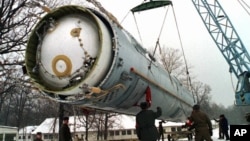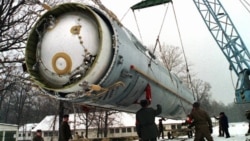Twenty years ago, the Soviet Union was disintegrating. As people all over the world watched this historic event, two United States Senators, Richard Lugar and Sam Nunn, realized that with the fall of the Soviet Union, there was a need to ensure the security of its vast arsenal of weaponry, including 30,000 nuclear warheads, bomb material for 60,000 more, and tens of thousands of metric tons of chemical and biological weapons, along with a large cadre of former weapons scientists that possess WMD-applicable expertise.
The new Russia, and the successor states lacked the stability and capacity to address this potential threat without assistance. And so Senators Lugar and Nunn sponsored the Cooperative Threat Reduction Program, or CTR, and quickly shepherded it through the legislative process. President George H. W. Bush then signed it into law.
Working together, the U.S. Departments of State, Defense, and Energy have made considerable progress in securing and dismantling Soviet-era weapons and their associated infrastructure and expertise. Security at nuclear, biological, and chemical sites has been greatly improved, and new opportunities have been created for former weapons scientists to engage in civilian research.
Since 1992, 7,551 nuclear warheads, 537 Intercontinental Ballistic Missiles and hundreds of missile silos, bombers, submarines, ground and submarine missile launchers and air-to-surface missiles have been decommissioned. Additionally, hundreds of tons of highly-enriched Uranium have been downgraded into material that cannot be used to build nuclear weapons and thousands of scientists have been put to work on peaceful, civilian projects.
“It took decades -— and extraordinary sums of money -— to build those arsenals; it’s going to take decades -— and continued investments -— to dismantle them,” said President Barack Obama at a symposium honoring Senator Lugar and former Senator Nunn, as well as the many men and women who participate in this initiative.
In recent years, the CTR programs have expanded both geographically and functionally, forging partnerships with more than 80 nations, from Africa to Asia, and global health organizations, to prevent bioterrorism and the spread of deadly diseases, while aiding the destruction of chemical weapons. Responding to emerging threats in the Middle East and North Africa provide an example of the important role that CTR continues to play as the program enters its third decade.
Just as CTR served as a creative solution to the unique security challenges at the end of the Cold War, the CTR program will continue to evolve and adapt to emerging WMD proliferation threats worldwide. By ensuring that these programs are addressing emerging threats wherever they might occur, CTR will continue to serve as a reliable tool for advancing U.S. and international diplomacy and security in the decades to come.
The new Russia, and the successor states lacked the stability and capacity to address this potential threat without assistance. And so Senators Lugar and Nunn sponsored the Cooperative Threat Reduction Program, or CTR, and quickly shepherded it through the legislative process. President George H. W. Bush then signed it into law.
Working together, the U.S. Departments of State, Defense, and Energy have made considerable progress in securing and dismantling Soviet-era weapons and their associated infrastructure and expertise. Security at nuclear, biological, and chemical sites has been greatly improved, and new opportunities have been created for former weapons scientists to engage in civilian research.
Since 1992, 7,551 nuclear warheads, 537 Intercontinental Ballistic Missiles and hundreds of missile silos, bombers, submarines, ground and submarine missile launchers and air-to-surface missiles have been decommissioned. Additionally, hundreds of tons of highly-enriched Uranium have been downgraded into material that cannot be used to build nuclear weapons and thousands of scientists have been put to work on peaceful, civilian projects.
“It took decades -— and extraordinary sums of money -— to build those arsenals; it’s going to take decades -— and continued investments -— to dismantle them,” said President Barack Obama at a symposium honoring Senator Lugar and former Senator Nunn, as well as the many men and women who participate in this initiative.
In recent years, the CTR programs have expanded both geographically and functionally, forging partnerships with more than 80 nations, from Africa to Asia, and global health organizations, to prevent bioterrorism and the spread of deadly diseases, while aiding the destruction of chemical weapons. Responding to emerging threats in the Middle East and North Africa provide an example of the important role that CTR continues to play as the program enters its third decade.
Just as CTR served as a creative solution to the unique security challenges at the end of the Cold War, the CTR program will continue to evolve and adapt to emerging WMD proliferation threats worldwide. By ensuring that these programs are addressing emerging threats wherever they might occur, CTR will continue to serve as a reliable tool for advancing U.S. and international diplomacy and security in the decades to come.

















